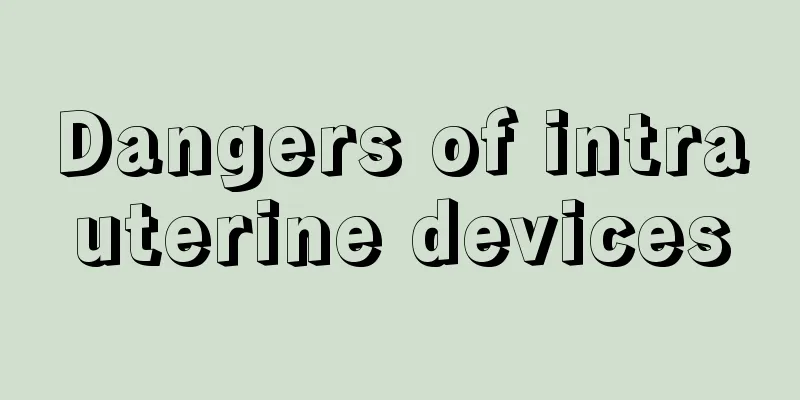Dangers of intrauterine devices

|
The intrauterine device, also known as the IUD, is a common contraceptive method in modern life. It mainly involves placing the IUD in the female's cervix to achieve the purpose of contraception. However, when women use intrauterine devices, it can cause great harm to their bodies and can easily lead to lower back pain or infection. Dangers of intrauterine devices The side effects of the IUD are mainly manifested in the following aspects: 1. Bleeding. It is currently believed that the IUD increases the activity of fibrinolytic enzymes and is the main cause of bleeding. 2. Lower back pain and abdominal distension. This may be because the IUD is too large or placed too low, causing uterine contractions. Third, infection. In a few cases, ascending infection may occur due to improper disinfection or aseptic operation. Fourth, IUD incarceration. Some IUDs may become embedded in the uterine muscle wall due to improper placement. 5. The IUD falls off. Shedding often occurs within the first year, especially in the first three months, during menstruation. 6. Pregnancy with an IUD. Pregnancy with an IUD may occur due to improper selection or placement of the IUD. The harm of IUD to women First, the patient lacks scientific knowledge about the relationship between vasectomy and sexual function before the operation, which leads to serious psychological burden and even depression after the operation; second, it is caused by organic complications caused by the operation. Therefore, before sterilization, it is very important to correct the patient's fundamental misunderstanding of vasectomy and relieve the patient's mental burden. For sexual dysfunction caused by complications, active symptomatic treatment is required. Tubal sterilization is a safe and reliable sterilization surgery, and the patient can choose to undergo tubal sterilization after a cesarean section, avoiding multiple surgeries. However, due to various reasons, some complications may still occur during and after the operation. Short-term postoperative complications include major and serious complications such as abdominal wall incision bleeding, hematoma, poor wound healing and infection, as well as adnexitis, pelvic inflammatory disease, peritonitis and even sepsis and toxic shock. Long-term postoperative complications include chronic pelvic inflammatory disease, intestinal adhesions, omentum syndrome, sterilization failure, and ectopic pregnancy. Although choosing different ligation methods can reduce the occurrence of complications, in general, the complications of fallopian tube sterilization are more numerous and serious than those of vasectomy. |
<<: What does category 3 breast hyperplasia nodules mean?
>>: How many mm is considered large for a breast cyst?
Recommend
Mixpanel: iPhone X penetration rate has surpassed iPhone 8 and iPhone 8 Plus
Data from mobile data analysis platform Mixpanel ...
How big is the fetus at eight weeks
The embryonic bud and fetal heart rate are the na...
Postpartum slimming exercise diagram
Most mothers have serious body shape changes righ...
What causes a lump in the chest? Beware of malignant tumors
Many women will have lumps in their breasts. Some...
Can I eat cold food if I have cervical erosion?
In summer, everyone likes to eat some cold food. ...
What should I do if my period comes and I have stomach pain?
Some women often joke that they will never be a w...
Normal weight comparison table for women
In today's society, both men and women have v...
Female right lower abdomen and lower back pain
Girls' pain in the lower right abdomen and wa...
Can I eat hotpot after I finish my confinement period?
The ingredients for hot pot can be said to be eve...
The best time for implantation is a few days after ovulation
If you want to increase the chances of successful...
Why are ETC services free now and all major banks promoting ETC? What's going on?
Only one ETC can be applied for per car. Car owne...
How to avoid adhesions after curettage
Uterine curettage is a necessary way for women to...
What should women eat to maintain their skin?
All female friends hope to have fairer, more deli...
Pregnant woman's belly
Pregnancy is not an easy thing. In the first thre...
Can I get pregnant normally with a retroverted uterus?
There are many women whose uterus is relatively b...









